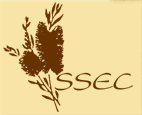Early Enterprises |
Fishing
The fish in Botany Bay were probably the staple diet of the Aboriginal people. A commercial fishing industry in Botany Bay commenced in 1790 operating mainly from the northern side, though there were isolated fishing shanties right around the bay from the earliest years. In 1815 James Birnie was granted his Alpha Farm and there he installed his caretaker/ manager who, apart from setting up the farm, fished the bay and sent the catch to Sydney along with his other produce.
The Booralee fishing village at Botany, on the northern shore of Botany Bay, was the first commercial fishing village in Australia. It began in the late 1820s and the name is an Aboriginal word meaning 'burley'. Today, the last three fishing dwellings in Booralee Street, though extensively renovated, have heritage classification. The relatively recent industrial and port complex of Botany now dwarfs them. |
 |
| By the 1850s fishermen had built many shacks on the shores of Boat Harbour and Weeney, Woolooware and Quibray Bays, and sent their salted catch across the Bay to the Sydney market. |
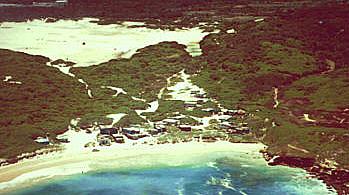
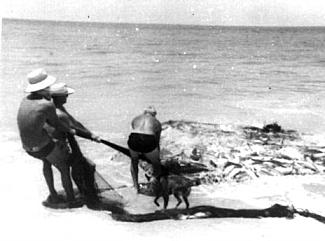 |
| During the second half of the nineteenth century there were at least seventy professional fishermen working Botany Bay and the Georges Rivers. As the relentless pursuit of seafood persisted, the numbers of fish diminished so that by 1920 there were less than 25 professional fishermen still operating in Botany Bay. |
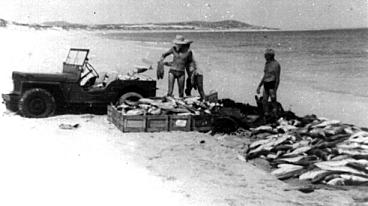
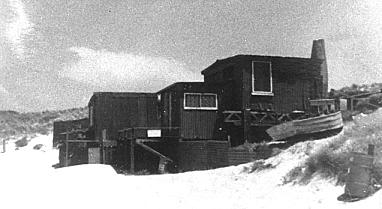 |
| From the 1940s to the 1960s conditions improved and increasing numbers of professional handline and net fishermen plied the waters of Botany Bay and the ocean 'outside', often returning with catches of large fish. Huge mullet schooled into the bay and along Silver Beach towards Bonna Point. Astute fishermen watched for their rising near Alpha House and set their nets from the beach at Bonna Point. They were often rewarded with impressive hauls. Sometimes they even joined three nets together to hold a bumper catch. |
 |
| The wharf in the Reserve near the Cook Obelisk, built in 1902 by the Lands Department, was a popular fishing spot for the locals and the visitors. But it was inconvenient for the professional fishermen; so they constructed a wharf off the end of Dampier Street. Unfortunately the tide was out when D. T. Match crossed the bay by ferry for the opening ceremony and the ferry was unable to approach the Dampier Street wharf. The ferry took him to the park wharf instead and he was obliged to return to Dampier Street wharf by pony cart to officiate. The Dampier Street wharf earned the name of 'Shag's Rest' and was strictly a high tide access wharf. Eventually it fell into disrepair, its remains being reported locally to be good firewood. |
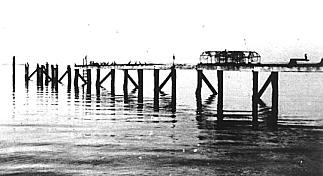 |
Several of the professional fishermen of 50 years ago had served their time as boat builders. In slow fishing periods they were able to turn their hand to their craft. The Fisher family, who owned and ran the ferries, built them at La Perouse. They also towed a boatshed from Sydney Harbour on a punt and re-erected it adjacent to Silver Beach Road in the 1920s. Bill Fisher built skiffs in this shed that has withstood all storms. It has been used for a sailing club, for seaweed harvesting and for boat building. Peter Bracken rented it and built his boats there before moving into his own shed in Ward Street. Today it is owned by Pete McWilliams, a retired professional fisherman who bought it from Bill Fisher in 1960 and continues to build boats there.
The recreational fishermen formed a fishing club that had its headquarters at Bonna Point. John Jones recalls that, in the 1950s, "Down the waterfront there at one time you'd get flounder over a foot long and ten inches wide and flathead up to three feet longwith a broom-stick and a six inch nail and just stab 'em! Lobsters, Gawd strike me, you'ld go up on the boulders there opposite the flagstaff and you could bend over and pick 'em up, lobsters over a foot long. It was nothing to pick up about 50 or 60 lobsters." |
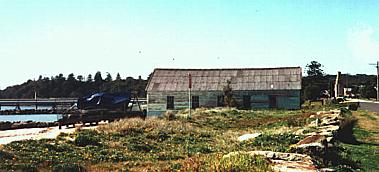 |
| Despite all the dredging, plus the development of the oil refinery and the construction of the airport runways, commercial fishing and prawn trawling remains active in Botany Bay and recreational fisherman too, can sometimes carry home a respectable catch. |
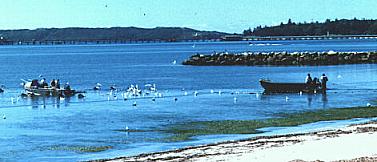 |
| In January 2000, NSW Premier Bob Carr announced a plan to introduce a $25 a year recreational fishing license along the coast to help fund a compulsory buy-out of the 90 commercial fishing licenses operating in Botany Bay and its tributaries and use the funds for fish-breeding programs. Botany Bay is one of NSW's most important fish nursery habitats and stocks are severely depleted. This announcement was met with protest by both commercial and recreational fishermen. However, as one fisherman stated: ".the problem is really with the state of the river itself, which still isn't being addressed." |
| top of page |
